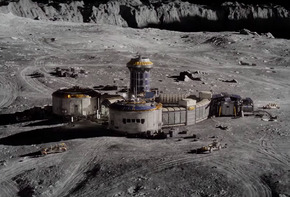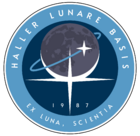Haller Base: Difference between revisions
No edit summary |
No edit summary |
||
| Line 104: | Line 104: | ||
==Structures== | ==Structures== | ||
===Original base (1987–1994)=== | ===Original base (1987–1994)=== | ||
The initial first component of the station, the pressurized ''Falkenhall'' Main Service Block (MSB) module and its adjacent {{wp|solar cell|solar arrays}} measuring 4,000 m<sup>2</sup> of operable area, were manufactured at the Gräbler Spaceflight Center near Rothenau, Aldia, beginning in 1982. The name ''Falkenhall'' was ultimately chosen by MAOA in reference to the oldest continuously inhabited urban settlement in modern-day Mascylla, having been founded by 600 BC. The modules were delivered on ship to the Spacecraft Processing Facility and Main Flight Operations Building at Cape Weimud Space Center in [[Akawhk]] in August of 1987 for final inspections, processing and preparation for launch. The module was designed with three {{wp|docking and berthing of spacecraft|docking ports}} suitable for {{wp|Common Berthing Mechanism|berthing}} operations, three autonomous arrays of solar cells measuring 4.5 by 1.3 meters (14.7 by 4.3 feet) mounted on its roof, six {{wp|nickel-cadmium battery|nickel-cadmium batteries}} with a capacity of 4 kilowatts of power, ten externally mounted fuel tanks holding 8.8 tonnes of propellant, and is outfitted with early communications and control equipment. ''Falkenhall'' has a dry mass of 21,492 kilograms (47,382 lb), is 8.2 meters (26.9 ft) long and 4.1 (13.5 ft) meters wide. | |||
''Falkenhall'' was launched on 6 November 1987 on a purpose-built and modified version of the {{wp|Saturn V|Atlant-3 rocket}} from Cape Weimud in Akawhk; the mission was incorporated into the Sigma program as the Sigma-Haller Expedition, crewed by a joint Dulebian-Mascyllary crew of Mission Commander Janus Heine. After the initial launch and the first two {{wp|multistage rocket|stage separations}}, the payload ascended to a 500 km (311 mi) high {{wp|parking orbit}} for re-configuration and trans-lunar flight preparations before firing the CSM third upper stage for {{wp|trans-lunar injection}} on 7 November. On 9 November, the two-stage ''Falkenhall'' module and its cargo load, referred to as LM ''Dnepr'', separated from the {{wp|Apollo Command Module|Sigma Command and Service Module}} (CSM) ''Antares'', having ferried it to lunar orbit, and descended to Luna's surface; ''Dnepr'' touched down at the ridges of Jenssen crater of the Soguichi Plateau at 05:22 UTC. The three astronauts stayed on the newly established lunar base before returning to the CSM in low orbit; the base module served as the launch pad for the ascent stage, similar in operation to the {{wp|Apollo Lunar Module|Sigma Lunar Module}} (LM), which then {{wp|lunar orbit rendezvous|docked with the CSM}} again and was subsequently discarded. After 6 days of stay, the crew of the Sigma-Haller Expedition returned to Aurorum on 18 November. | |||
The ascent stage of ''Dnepr'' inadvertently polluted the photovoltaic arrays with whirled up {{wp|lunar regolith}}, which caused ''Falkenhall'' to suffer a {{wp|blackout}} one day after Sigma-Haller's departure. Contact to the automatic systems of the station remained severed until Haller 87 could clean and re-orientate the solar arrays while moving them 700 meters (2,297 feet) away from the designated but improvised landing and take-off site, two weeks later in December of 1987. | |||
===Added modules (1994–1999)=== | ===Added modules (1994–1999)=== | ||
===Other elements=== | ===Other elements=== | ||
Revision as of 22:03, 6 June 2022
This article is incomplete because it is pending further input from participants, or it is a work-in-progress by one author. Please comment on this article's talk page to share your input, comments and questions. Note: To contribute to this article, you may need to seek help from the author(s) of this page. |
Haller Base Lunar Station | |
|---|---|
 Haller Base facilities on the surface in 2008 | |
| File:Location of Haller Base.png | |
| Sovereign state | |
| Location on Luna | Jenssen crater, Soguichi Plateau |
| Administered by | Lunar Exploration Initiative of the MAOA and Air Force |
| Established | 9 November 1987 |
| Retired | 15 February 2009 |
| Named for | Emil G. Haller |
| Population (1987 / 2008) | |
| • Total | 5 / 13 |
| Type of operation | |
| • Crew | All year-round |
| Operation | |
| • Status | Inoperational |
| Dimensions |
|
| Facilities | 6 buildings and facilities:
|
Haller Base, officially the Haller Base Lunar Station (Hesurian: Haller-Basis Lunare Forschungsstation), is a Mascyllary research station in the Jenssen crater of the Soguichi Plateau on the surface of Luna, the second planet of the world's binary planet system. It was operated under the Lunar Exploration Initiative (MLEI) jointly of the MAOA and Air Force from 1987 to 2009 and is considered to be the furthermost point of Mascyllary jurisdiction and only one on Luna. The base is named in honour of rocketry pioneer and polar explorer Emil Haller who was a significant contributor to the foundation of the MAOA and its early human spaceflight projects.
Haller Base is the first modular planetary station and first large man-made structure on Luna, and was assembled by three separate missions from 1987 to 1999. The original base, less than a fifth of the completed station's volume, landed as part of the Sigma-Haller mission on 9 November 1987 by the space agencies of Mascylla and Dulebia as part of the Sigma program. With the Haller 87 and Haller 88 missions, the base became the first continuously inhabited research station on Luna and still maintains the longest duration of continuous human presence in space at 4,018 days. Since, the station has hosted up to 117 astronauts, the largest number for any Lunar research station, and has been repeatedly partially rebuilt and expanded upon. By 2008, Haller Base encompassed five pressurized modules, and two unpressurized components, the Wilhelm G. Neumayer Astronomical Observatory and the power-supplying photovoltaic array.
The station was purposefully constructed to and served as a research laboratory which enabled crews to conduct scientific experiments on human biology, microgravity and radiation physics, astronomy, meteorology and space physics and study the effects of long-term stay in space on humans. While the base operations and crew were militaristic in nature, it allowed scientific endeavours such as international collaborations with other countries to access the station. Haller 87 sustained five crew members, but the station's population continued to grow through its operation, with a peak 13 crew members of Haller 04 simultaneously on the station. In service from 1987 to 2009, Haller Base continued human presence on Luna, before it was agreed upon by the MLEI to retire the station in February 2009 mainly due to its aging hardware, damages sustained by meteorological phenomena and regolith exposure. The station has since been unoccupied and plans to either repurpose it for another settlement or preserve it as a protected area have been proposed.
Structures
Original base (1987–1994)
The initial first component of the station, the pressurized Falkenhall Main Service Block (MSB) module and its adjacent solar arrays measuring 4,000 m2 of operable area, were manufactured at the Gräbler Spaceflight Center near Rothenau, Aldia, beginning in 1982. The name Falkenhall was ultimately chosen by MAOA in reference to the oldest continuously inhabited urban settlement in modern-day Mascylla, having been founded by 600 BC. The modules were delivered on ship to the Spacecraft Processing Facility and Main Flight Operations Building at Cape Weimud Space Center in Akawhk in August of 1987 for final inspections, processing and preparation for launch. The module was designed with three docking ports suitable for berthing operations, three autonomous arrays of solar cells measuring 4.5 by 1.3 meters (14.7 by 4.3 feet) mounted on its roof, six nickel-cadmium batteries with a capacity of 4 kilowatts of power, ten externally mounted fuel tanks holding 8.8 tonnes of propellant, and is outfitted with early communications and control equipment. Falkenhall has a dry mass of 21,492 kilograms (47,382 lb), is 8.2 meters (26.9 ft) long and 4.1 (13.5 ft) meters wide.
Falkenhall was launched on 6 November 1987 on a purpose-built and modified version of the Atlant-3 rocket from Cape Weimud in Akawhk; the mission was incorporated into the Sigma program as the Sigma-Haller Expedition, crewed by a joint Dulebian-Mascyllary crew of Mission Commander Janus Heine. After the initial launch and the first two stage separations, the payload ascended to a 500 km (311 mi) high parking orbit for re-configuration and trans-lunar flight preparations before firing the CSM third upper stage for trans-lunar injection on 7 November. On 9 November, the two-stage Falkenhall module and its cargo load, referred to as LM Dnepr, separated from the Sigma Command and Service Module (CSM) Antares, having ferried it to lunar orbit, and descended to Luna's surface; Dnepr touched down at the ridges of Jenssen crater of the Soguichi Plateau at 05:22 UTC. The three astronauts stayed on the newly established lunar base before returning to the CSM in low orbit; the base module served as the launch pad for the ascent stage, similar in operation to the Sigma Lunar Module (LM), which then docked with the CSM again and was subsequently discarded. After 6 days of stay, the crew of the Sigma-Haller Expedition returned to Aurorum on 18 November.
The ascent stage of Dnepr inadvertently polluted the photovoltaic arrays with whirled up lunar regolith, which caused Falkenhall to suffer a blackout one day after Sigma-Haller's departure. Contact to the automatic systems of the station remained severed until Haller 87 could clean and re-orientate the solar arrays while moving them 700 meters (2,297 feet) away from the designated but improvised landing and take-off site, two weeks later in December of 1987.
